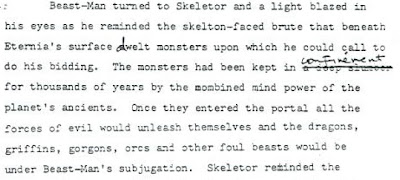 |
| Masters of the Universe Preview, 1982, Artist: Curt Swan and/or Dave Hunt |
When most people think about the He-Man mythos (assuming they think about it at all) they recollect the 1983 Filmation series, but the Masters of the Universe had a history before the series – one with significant differences from what would become 'official' canon.
When He-Man was just an action figure, mini-comics accompanied MOTU merchandise. Although called mini-comics, the early ones were more like mini-story books, with a single graphic covering most of each page and a few lines of text beneath. Regardless, the point was to provide the basis of play – a narrative stage that established a fictional environment, the identities of the characters, and the ways in which they interacted. Alfredo Alcala was the artist for the first series of mini-comics and Don Glut was the author. Glut is a man with a variety of talents and interests. Listing his many creations is beyond the scope of this post; however, as an example of his inventiveness, allow me to say he is the person responsible for Tragg and the Sky Gods (among other Gold Key titles).
 |
| “They will add to your strength, use them wisely...” |
 |
| Note the golden unicorn fighting Skeletor |
 |
| “...magic fires, created by ancient scientists and sorcerers...” |
In 1982, still prior to the Filmation series, DC Comics published actual MOTU comic books. These were written by Paul Kupperberg who (along with Jan Duursema) created Arion, Lord of Atlantis prior to scripting the MOTU comics. At the time, Arion was your humble host's favorite title. Alas, it was Kupperberg who implemented the idea of Prince Adam as He-Man's “secret identity.” Keep in mind that Kupperberg's version of Adam had incredible strength.
So, He-Man is a blond, incredibly strong dude with a Dutch boy hairstyle and Prince Adam is a blond, incredibly strong dude with a Dutch boy hairstyle. You would think that people would be suspicious. Oh wait, Prince Adam has a cowardly green-and-yellow tiger who talks while He-Man has a courageous green-and-yellow tiger who talks. Yeah, I guess that's enough to throw off anybody. Another thing I dislike about Kupperberg's Eternia is the technological disparity between the aristocracy and the peasants. To my knowledge, Skeletor never capitalized on this.
In late 1982, Mattel approached Michael Halperin to write a 'bible' for the Filmation series. Halperin came up with the good idea of Adam/He-Man's mother being an astronaut from Earth, but not all of Halperin's ideas became canon. In Halperin's story, Evil-Lyn, Beast Man, and Tri-Klops were originally 'normal' Earth humans (and Beast Man's name was Biff – no lie).
If there was any one thing that ruined MOTU for me, it was Orko. I appreciate the 'need' for a comic relief character, but why Orko? I'd rather have Gwildor. For that matter, a dozen Trobbits would be preferable to Orko. It is Halperin we have to thank for Orko; however, in Halperin's bible he's called “Gorpo,” which is a more fitting name I think.
Halperin seems to have been familiar with D&D.
Where else would he get 'quasit' from? Halperin also includes dwarves, trolls, gnolls, manticores, wyverns, basilisks, and giant centipedes in his bible. In the following passage, we are told that Beast Man can supposedly control orcs.
Orcs (or at least creatures called orcs) appear in one of the later mini-comics.
 |
| “Orcs” in masks. Can you tell they're evil? |
Skeletor doesn't use this ability often enough in my opinion.
 |
| Skeletor, “Dark Lord,” channels Darth Vader |




The thing about the Filmation cartoon was that it was made to appeal to boys as young as 4 or 5. Really little kids loved the transformation sequence, and they'd get it in the intro and 2-4 times more per episode. The bad guys couldn't be genuinely scary, so they were all incompetent instead. And there were half-assed "messages" inserted for the kids that cartoons like Blackstar and Thundarr never bothered with.
ReplyDeleteGood point about the transformation, but it need not be a 'Prince Adam to He-Man' transformation. They could have gone the Popeye & spinach route; He-Man is always He-Man but when he's on the ropes, he summons the power of Grayskull. For purposes of viewer identification, they could have had a kid transform into He-Man. Didn't one of the later series do that?
DeleteSure, the bad guys can't be scary, but why do they have to be incompetent? Why can't they be unlucky? Or just susceptible to the clever tactics of the good guys?
Honestly, I don't mind the half-assed messages; even myths have messages.
That Prince Adam identity was always a bad idea! I cant think of a good reason to have it in the first place?
ReplyDeleteI have also became interested in the mini-comics. There is so much more potential for adventure with the mini-comics, then with the cartoon, and you don't have to wait for some dandy pool-boy to sneak-off so he can turn into the most powerful Chippendale in the universe. The whole Kingdom element also adds an unnecessary degree of stability and cultural focus to the setting. He-Man would be a better hero if he has to build a kingdom from the ground-up, gaining many allies and supporters along the way. The post-apocalyptic nature would add a greater level mystery and danger to the world. Being able to fight across worlds and dimensions, as noted in the first mini-comic, would allow for new environments, and to better introduce more exotic creatures and characters (e.g. Trap-Jaw in the mini-comic). On top of that, He-Man can be striped of his super-powers by removing his gear - to do that in the Cartoon, would reveal his secret identity.
If you like reading the old mini-comics, I highly recommend checking-out Battles Across Eternia, The Triumph of Skeletor, and Menace from the Past.
Great article, by the way!
Thanks for the links!
Delete